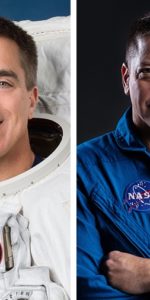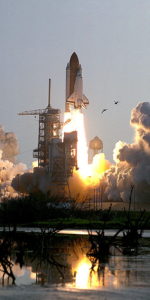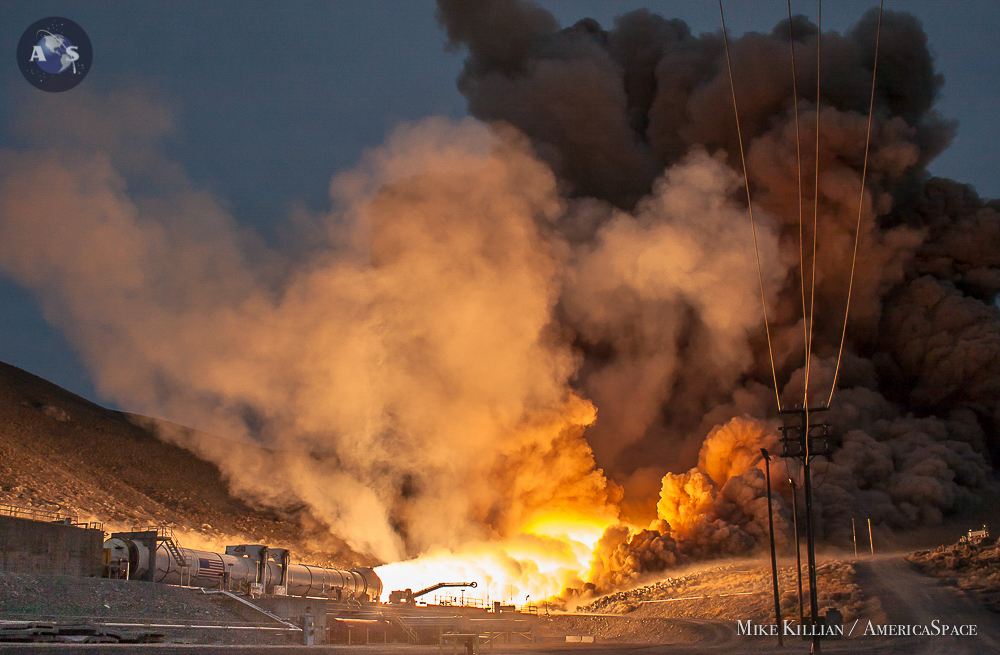
The launch of Artemis-1 has drawn a step closer to returning a human-capable spacecraft to the Moon, following Northrop Grumman Corp.’s announcement on Monday, 15 June, that segments of the twin solid-fueled boosters assigned to the first Space Launch System (SLS) had arrived safely at the Kennedy Space Center (KSC) in Florida.
Each 177-foot-long (53.9-meter) booster comprises five segments—significantly larger and more capable than the four-segment Solid Rocket Boosters (SRBs) used during the 30-year-long shuttle era—and will provide around 75 percent of the liftoff thrust as an SLS departs the Cape’s historic Pad 39B for its maiden voyage late in 2021.
“The arrival of the booster segments at Kennedy is just the beginning of the SLS rocket’s journey to the pad and onward to send the Orion spacecraft to the Moon,“ said NASA Administrator Jim Bridenstine. “Artemis-1 will pave the way toward landing the first woman and the next man on the surface of the Moon in 2024 and expanding human exploration to Mars.”
“New technologies and material upgrades enable the boosters to meet the high-performance demands of SLS, the most powerful rocket NASA has built to date,” said former shuttle astronaut Charlie Precourt, vice president for propulsion systems at Northrop Grumman. “Our technology will help propel the first woman and the next man to the Moon.” In the Monday news release, Northrop Grumman noted that the reliability and lower manufacturing cost of the five-segment booster has been made possible by leveraging the success and flight-proven design of the original SRB, which flew 270 times between April 1981 and July 2011 to boost 135 shuttle missions off the launch pad.
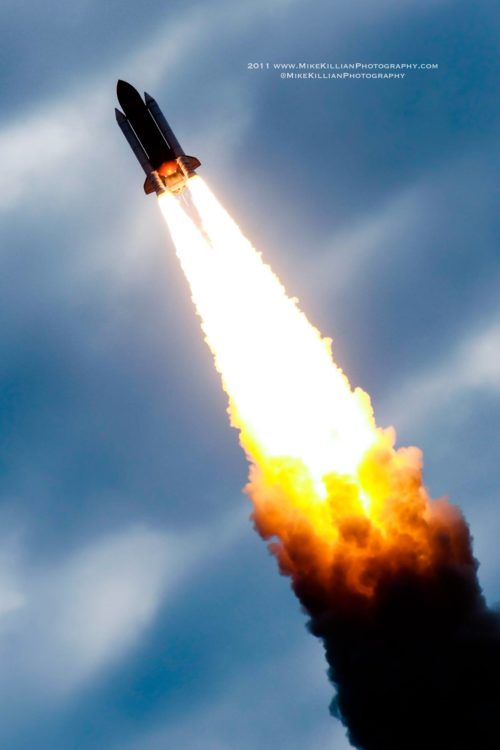
During each shuttle mission, a pair of four-segment SRBs provided the lion’s share of the thrust needed to get the vehicle and crew into orbit. However, even whilst the shuttles were still flying proposals were laid for a five-segment booster with a modified nozzle, which carried potential enhancements in terms of safety, payload-to-orbit performance and reduced system costs.
In March 1999, the first study contracts were awarded to a team of contractors including United Space Alliance (USA), Thiokol Propulsion, Boeing North American and Lockheed Martin. A five-segment SRB would help eliminate the shuttle’s hairy Return to Launch Site (RTLS) and Transoceanic Abort Landing (TAL) abort modes and provide greater capacity to execute an Abort Once Around (AOA) in the event of a Space Shuttle Main Engine (SSME) failure shortly after liftoff. And it would boost the shuttle’s payload-to-orbit capacity by almost 20,000 pounds (9,000 kg) to 60,000 pounds (27,200 kg). Total thrust from two of these five-segment behemoths would have come in at around 3.6 million pounds (1.6 million kg), a significant power increase over the 2.8 million pounds (1.3 million kg) attainable by the earlier four-segment booster.
Following to loss of Columbia in February 2003, the five-segment booster was shelved (for the shuttle program, at least), but later revived in support of NASA’s Constellation Program and the Ares V rocket. In September 2009, Development Motor-1 (DM-1) was satisfactorily test-fired by Alliant TechSystems, Inc. (ATK) at its Promontory, Utah, facility. The successful test provided useful thrust, roll-control, acoustics and motor-vibration data, ahead of the two-minute-long, full-flight-duration DM-2 in August 2010 which saw 760 instruments monitor 53 test objectives. These tests evaluated the performance of the booster, including its wider nozzle “throat”, upgraded asbestos-free insulation and liner.
With the cancelation of Ares V and the Constellation Program by the Obama Administration in 2010, new life was breathed back into the five-segment booster with NASA’s announcement of the Space Launch System (SLS). In September 2011, the full-flight-duration DM-3 test evaluated its performance at high temperatures and, following scaled-down tests of the design early the following year, in October 2012 NASA awarded contracts to ATK to “demonstrate innovations” for the five-segment booster, two of which would power each SLS. Elsewhere, the heavylift rocket itself progressed smoothly through its Preliminary Design Review (PDR) in August 2013 and its Critical Design Review (CDR) in October 2015, cementing an architecture which, in addition to the two boosters, would also feature a core stage propelled by a suite of shuttle-heritage RS-25 engines.
In the meantime, Orbital ATK—the result of a 2014 merger between ATK and Orbital Sciences Corp.—conducted the two-minute-long Qualification Motor-1 (QM-1) test-firing in March 2015, which saw the booster punch out 3.6 million pounds (1.6 million kg) of thrust at peak operating temperatures of 32 degrees Celsius (90 degrees Fahrenheit). This was intended to represent the “high end” of its accepted propellant temperature range. And in June 2016, the QM-2 test repeated the exercise at 4.5 degrees Celsius (40 degrees Fahrenheit), the colder end of its propellant temperature range.
According to Northrop Grumman Corp., which completed acquisition of Orbital ATK two years ago, casting of propellant into the aft segment of the left-hand booster—the first component—got underway in April 2016. Since then, in September 2017, the avionics unit to control the ignition and separation of the boosters and communicate with SLS on-board computers completed its final qualification test.
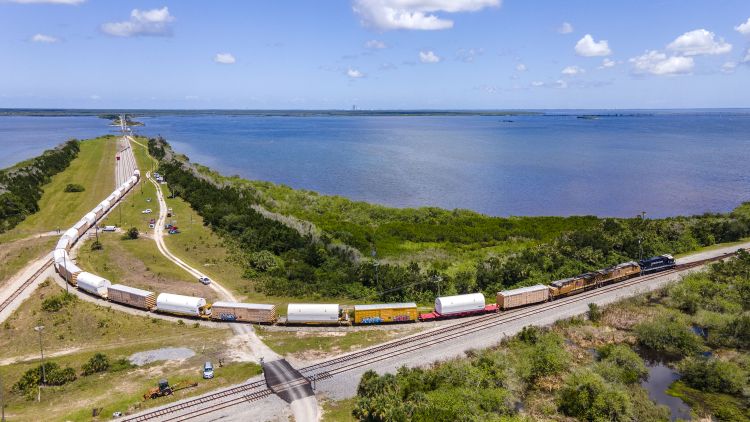
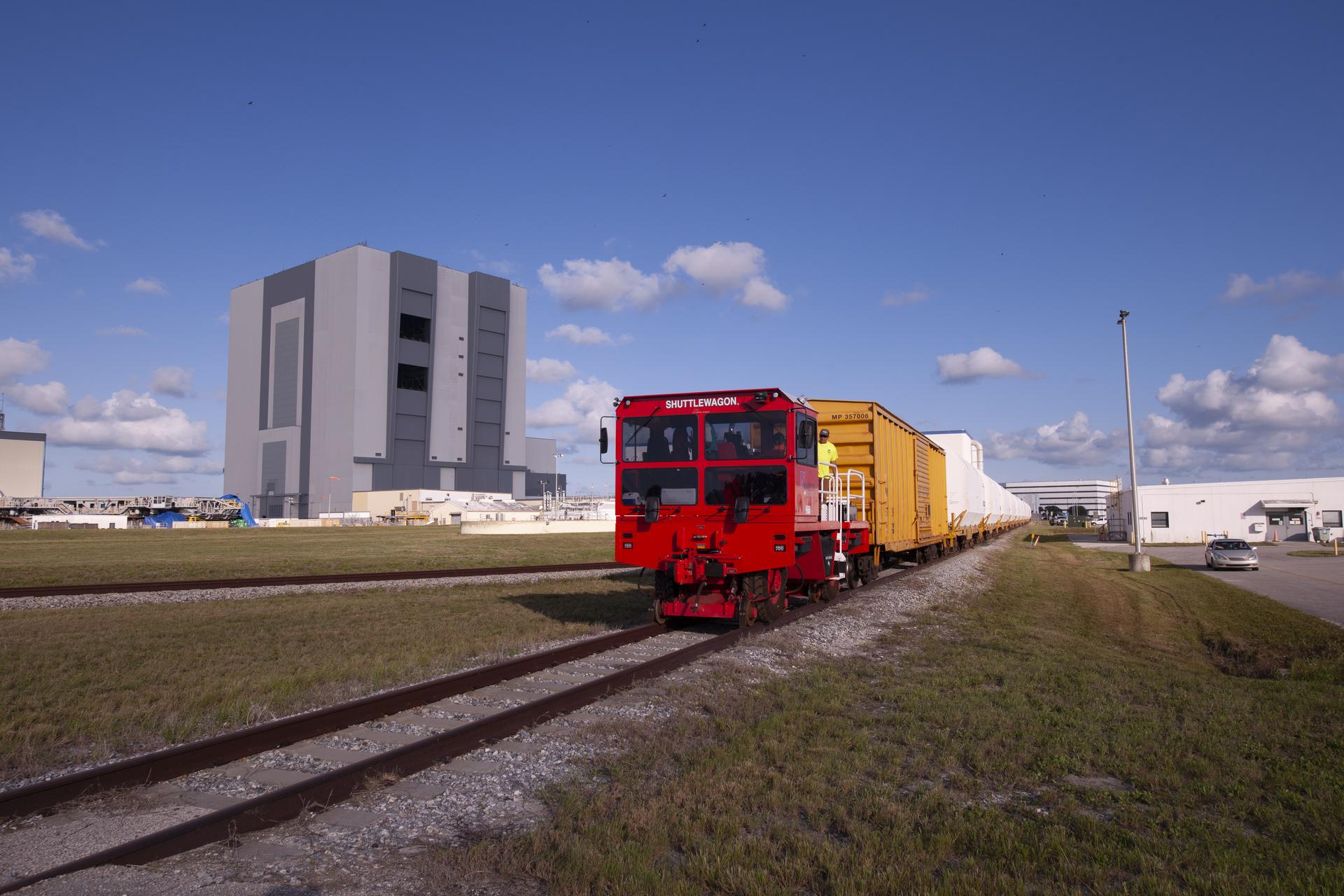
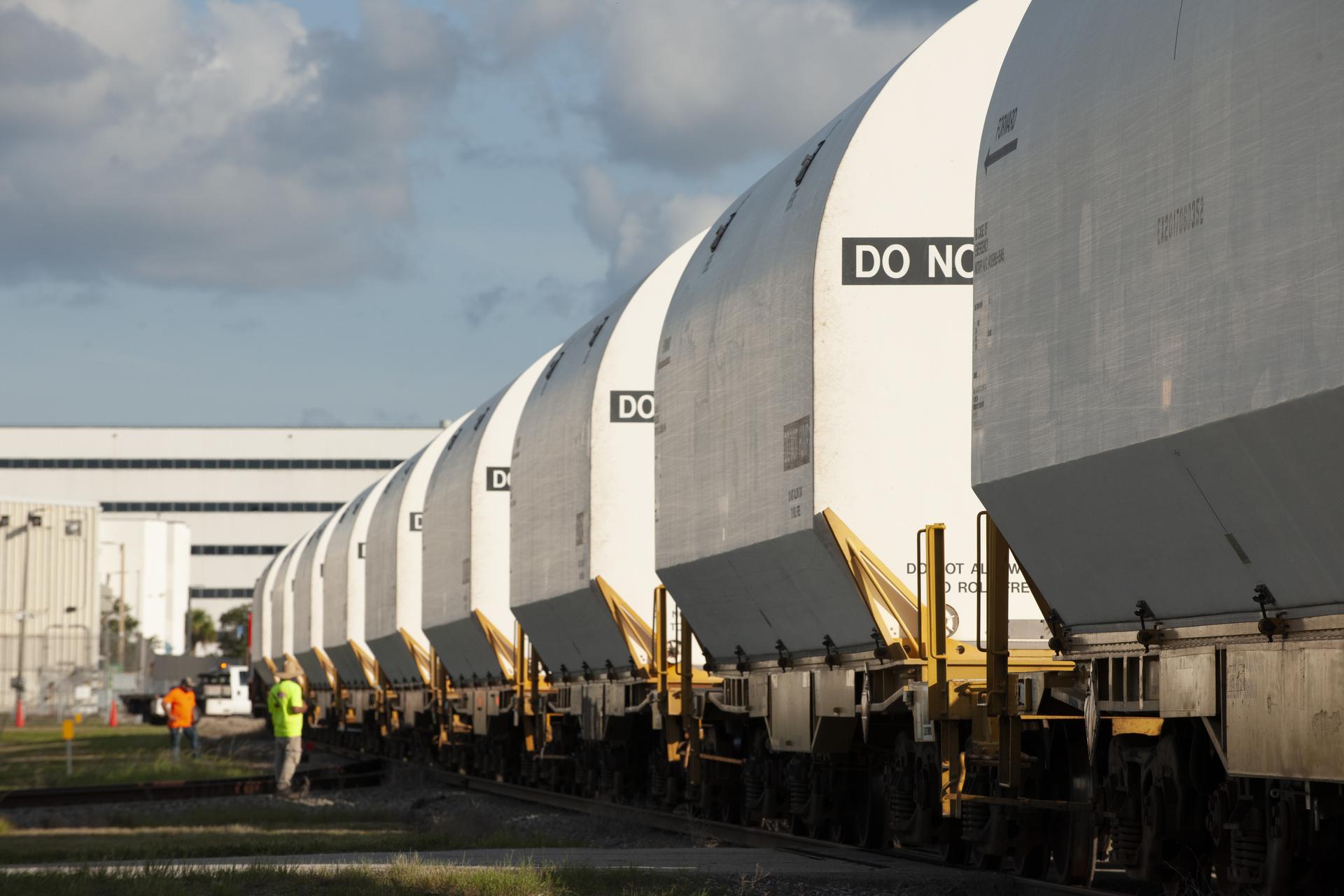
Following arrival by rail at the Cape, the booster segments for Artemis-1 will be atored until the core stage completes its Green Run Test campaign at Stennis Space Center. Once that is complete the process will begin at KSC to stack the booster segments in preparation for the core stage arrival.
Once in the Vehicle Assembly Building (VAB), engineers will use twin 400,000-pound (180,000 kg) cranes to lift the segments from horizontal to vertical. In the meantime, the boosters’ aft skirts will arrive at the RPSF from the nearby Booster Fabrication Facility (BFF) and be installed onto the aft segments. There they will remain until the SLS core stage is ready to accept them. The segments will be transported to the VAB transfer aisle and lifted by crane into High Bay 3, preparatory for stacking.
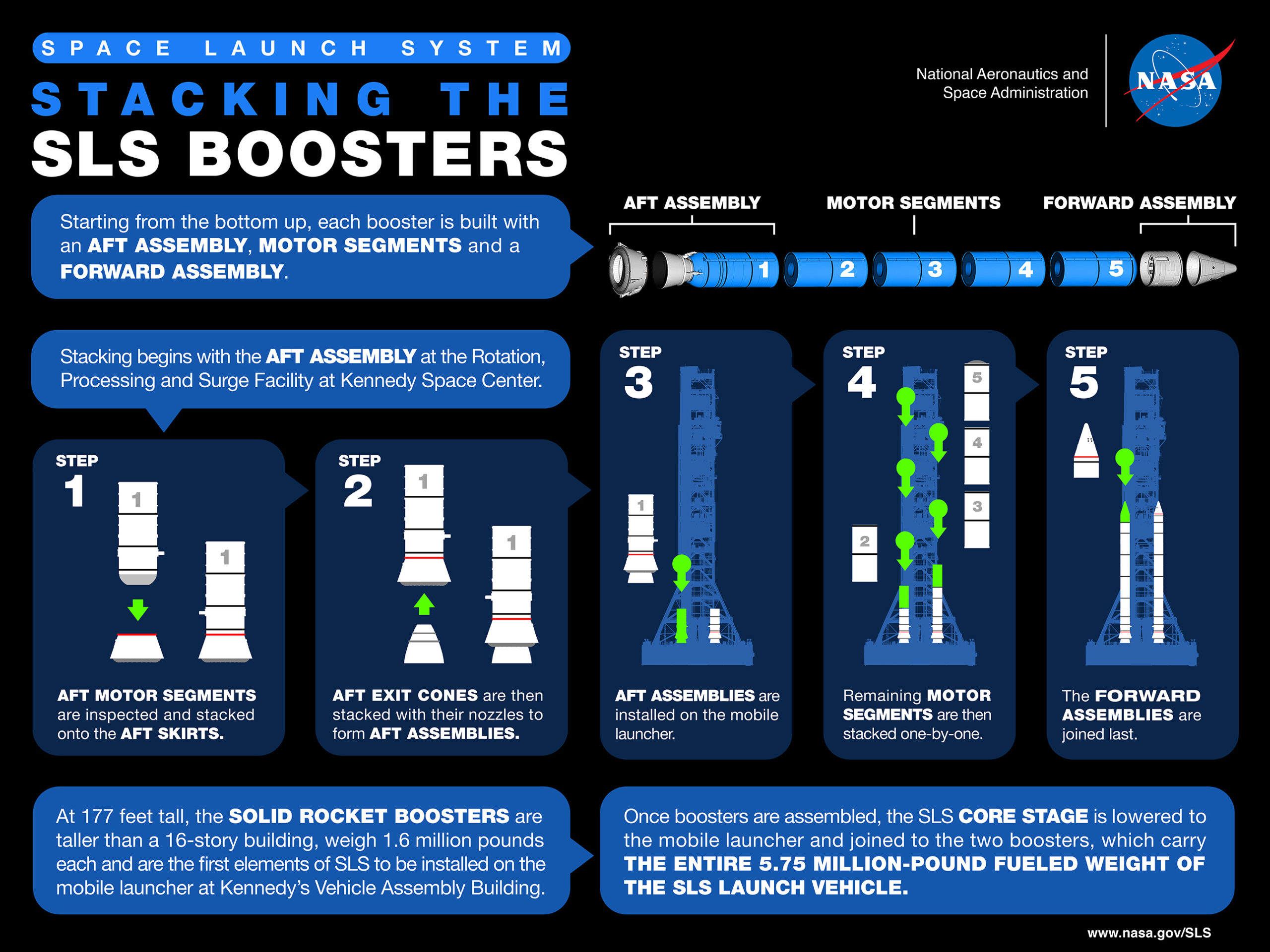
Repeatedly delayed beyond its originally targeted maiden launch date of 2017, the SLS is currently slated to fly the uncrewed Artemis-1 spacecraft—previously designated “Exploration Mission-1” (EM-1)—at some point in late 2021. It will rise from storied Pad 39B, which to date has seen 59 launches, from the Apollo 10 lunar voyage in May 1969 to four Saturn IB flights in support of Skylab and the Apollo-Soyuz Test Project (ASTP) and from 53 shuttle missions to the Ares I-X test in October 2009.
Current planning envisages the combined might of the SLS core stage and the twin boosters pushing Artemis-1 around the Moon for the first all-up test of a human-rated vehicle on a lunar voyage since Apollo 17 in December 1972.
.
.
FOLLOW AmericaSpace on Facebook and Twitter!
.
.




